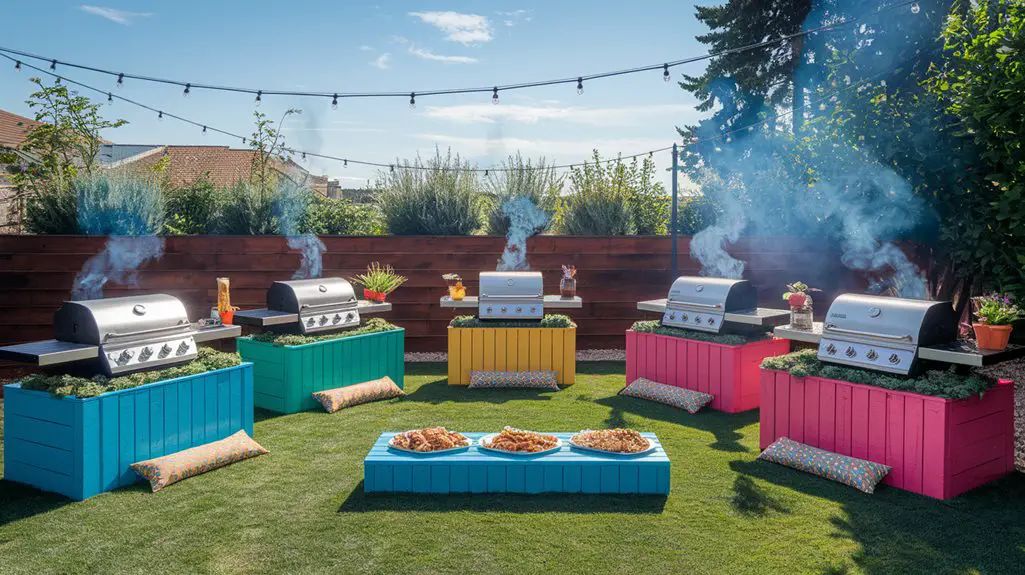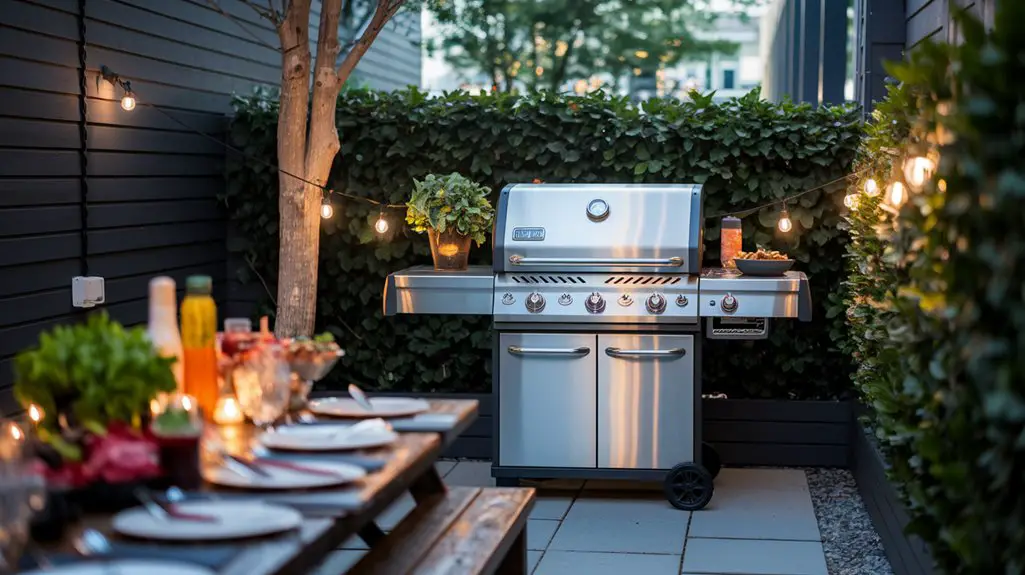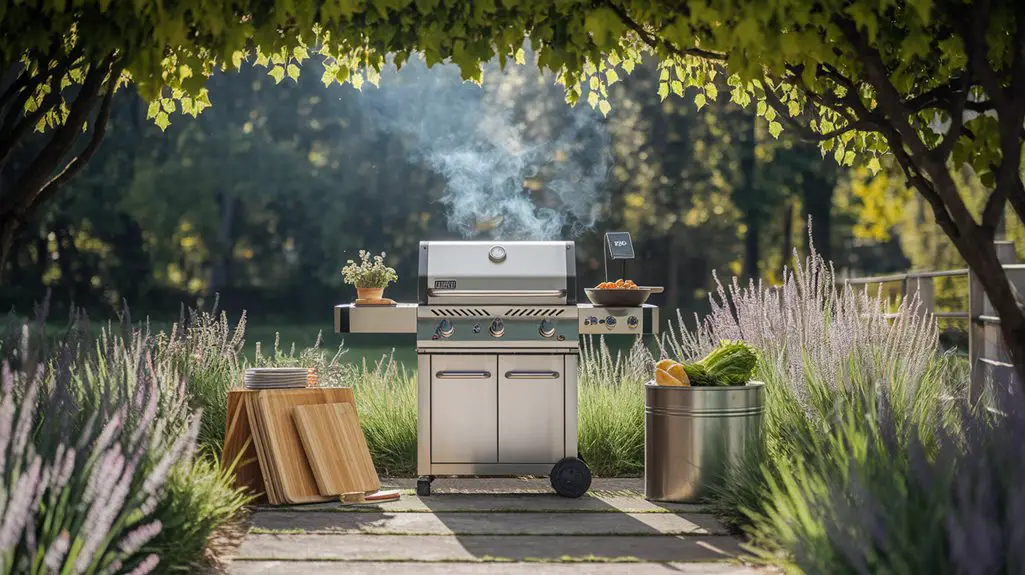Creating an urban backyard habitat? Start by choosing native plants that flourish in your area's climate, drawing pollinators and boosting biodiversity. Vertical gardens are a space-saving solution, enhancing air quality and aesthetics. A bird-friendly environment may include feeders and shelters, while water features like birdbaths or small ponds attract diverse wildlife. Incorporate eco-friendly practices to craft a balanced ecosystem. Ready for detailed steps to enhance your urban oasis?
Selecting Native Plants for Urban Gardens
When planning your urban garden, selecting native plants offers a sustainable way to create a harmonious ecosystem right in your backyard. Choosing native species is essential due to their adaptability to local soil and climate conditions, reducing the need for chemical inputs and intensive watering. This results in lower maintenance and resource consumption.
Design your garden by researching plants that thrive in your specific urban environment. Consider color palettes and growth patterns to guarantee a cohesive visual appeal that complements your space.
Native plants also attract local pollinators, enhancing biodiversity and supporting the broader urban ecosystem. Additionally, incorporating best native plants can further improve your garden's resilience and aesthetic appeal.
You're making an environmentally-conscious choice by integrating plants that naturally coexist, leading to a resilient and ecologically balanced garden that thrives with minimal intervention.
Creating Vertical Gardens for Limited Space
Maximize your limited urban space by creating a vertical garden, a smart design choice that promotes sustainability.
Start by evaluating your wall's weight capacity; it's crucial for supporting structure. Choose modular systems with interchangeable panels; they permit easy plant reshuffling, enhancing design flexibility. Opt for lightweight materials like recycled plastic or metal to guarantee durability and eco-friendliness.
Vertical gardens improve air quality, creating microhabitats, while aesthetically elevating your space. Use drip irrigation systems to conserve water and enable efficient maintenance.
Select plants with various textures and colors, focusing on hardy species that thrive in compact environments. Install your design in highly visible yet functional areas, adding green layers without sacrificing ground footprint.
Keep an eye on sun exposure, adjusting plant choices accordingly. Incorporating stunning vertical garden ideas can inspire creativity and boost the overall appeal of your outdoor area.
Designing a Bird-Friendly Environment
Although urban environments may appear challenging for wildlife, designing a bird-friendly habitat in your backyard can greatly improve biodiversity while enhancing the aesthetic value of your space.
Start by incorporating native trees and shrubs that provide food and shelter like serviceberry or elderberry. Install bird feeders and baths to supply essential nutrients and water. Make sure feeders are cleaned regularly to prevent disease. Use a diverse range of seeds, suet, and nectar to attract various species.
Position nesting boxes in sheltered areas to provide safe breeding sites. Utilize sustainable materials in construction for an environmentally-conscious approach. Minimize reflective surfaces to prevent bird collisions. Additionally, consider adding best plants for attracting birds, as they can significantly enhance your backyard's appeal to various avian species.
Through thoughtful planning, your urban backyard can become a thriving refuge for local and migratory birds.
Attracting Pollinators With Flowering Plants
A key component to attracting pollinators in urban spaces is selecting flowering plants that provide abundant nectar and pollen. Choose native species – they're adapted to local climates and require less maintenance. Prioritize a diverse bloom period for continuous sustenance.
| Flowering Plant | Bloom Period |
|---|---|
| Milkweed | Early Summer |
| Bee Balm | Mid-Summer |
| Goldenrod | Late Summer to Fall |
Incorporate these plants into your urban backyard to support essential pollinators like bees, butterflies, and hummingbirds. Maximize benefits by planting clusters, enhancing visibility and accessibility. Opt for varied colors and forms to cater to different species. By designing a vibrant habitat, you're not just beautifying your space, you're also advancing biodiversity and ecological health in the urban landscape. Additionally, creating wildlife habitats with native plants can significantly improve ecosystem resilience in urban areas.
Incorporating Water Features for Wildlife
Consider integrating a water feature to attract and support urban wildlife in your backyard.
Begin by evaluating your available space. Options like birdbaths, small ponds, or rain gardens work well in urban settings. Choose materials that are sustainable and local to minimize your environmental impact; for example, natural stone or recycled materials.
Install a solar-powered pump to circulate water, guaranteeing oxygenation without increasing your energy footprint.
Placement is essential—position your water feature in a partially shaded area to prevent rapid evaporation while maintaining a natural appearance.
Add native aquatic plants to provide shelter and food for visiting wildlife. Additionally, make sure there are gradual slopes around the edges to allow easy access for small animals.
Incorporating a koi pond can enhance the beauty of your garden while also attracting urban wildlife.
Through thoughtful design, you'll create a thriving mini-ecosystem in your urban space.
Implementing Sustainable Gardening Practices
Sustainable gardening practices complement your water feature and further enrich your urban backyard habitat.
Start by selecting native plants—they're adapted to your local climate and require minimal watering.
Design raised beds or use vertical structures to maximize space efficiency.
Implement a drip irrigation system to minimize water wastage and guarantee moisture reaches roots directly.
Composting is essential; it enriches soil, reduces waste, and supports plant growth.
Use organic mulch to retain soil moisture and suppress weeds.
Choose permeable hardscapes to improve rainwater absorption.
Avoid chemical pesticides and fertilizers; instead, use natural alternatives like neem oil or beneficial insects.
Focus on biodiversity—vary your plant types to create a thriving ecosystem. Additionally, implementing eco-friendly gardening techniques can further enhance your sustainability efforts while supporting local wildlife.
Installing Birdhouses and Feeders
Incorporating birdhouses and feeders into your urban backyard habitat can transform it into a thriving avian oasis. Opt for eco-friendly materials such as sustainably harvested wood or recycled metal to design structures that blend seamlessly into your urban landscape.
Consider the placement of birdhouses at various heights and orientations to cater to different species and their needs. Utilize feeders to provide essential sustenance year-round, supporting local avian populations and encouraging biodiversity.
- Consider shapes: Use varied designs to attract diverse bird species.
- Install securely: Confirm birdhouses and feeders are mounted safely to withstand urban weather conditions.
- Select sustainable materials: Favor eco-friendly options to minimize environmental impact.
- Prevent overcrowding: Space feeders apart to reduce competition among birds.
- Promote visual appeal: Choose designs that enhance your backyard aesthetics while supporting wildlife.
Additionally, incorporating natural pest control methods in your backyard can help create a healthier environment for birds and other wildlife.
Crafting a Safe Haven for Small Mammals
Sheltering small mammals in your urban backyard demands careful planning to guarantee their safety and comfort.
Start by designing a space with diverse vegetation for natural cover. Use native plants that attract insects and foster a balanced ecosystem. Incorporate a small brush pile, providing essential shelter. Make sure these elements mimic the creatures' natural habitat to help them thrive.
Create burrows or nest boxes using untreated wood or natural materials. Position these shelters strategically, away from pets or human traffic, to minimize disturbances.
Promote a pesticide-free environment by opting for organic maintenance. Water is crucial—add a shallow dish for drinking, refreshed regularly. Additionally, consider adding wildlife-friendly features such as bird baths and pollinator gardens to further enhance the habitat.
Lastly, verify city regulations implicated in attracting wildlife. This conscientious approach not only supports small mammals but enriches urban biodiversity.
Building a Butterfly and Bee Oasis
Following the creation of a safe haven for small mammals, redirect your focus to building a butterfly and bee oasis.
Consider incorporating native plants that provide essential nectar and pollen. Design features should cater to the specific needs of these pollinators, contributing positively to urban biodiversity.
Employ a variety of plants that bloom at different times to support them throughout the seasons. Use natural materials, avoiding pesticides that can harm these delicate insects.
Enhance your design by including:
- Native flowers: Opt for species like milkweed and bee balm, which attract butterflies and bees.
- Water sources: Incorporate shallow dishes with pebbles for hydration.
- Shelter structures: Construct bee hotels or place flat stones for basking.
- Vertical plantings: Maximize space and create visual interest.
- Organic maintenance: Prioritize eco-friendly gardening practices.
Additionally, consider creating a pollinator-friendly herb garden that can further entice these important insects.
Conclusion
In your urban garden, you're not just planting greenery; you're weaving a living tapestry that enriches biodiversity. Like architects of nature, you guide native plants to flourish, drawing in pollinators and birds like magnets. Through vertical gardens, you maximize space and elevate air quality. Water features quench wildlife's thirst, and thoughtfully placed shelters offer refuge. Every layer you add crafts a harmonious ecosystem, a demonstration of sustainable design in the heart of the city.




